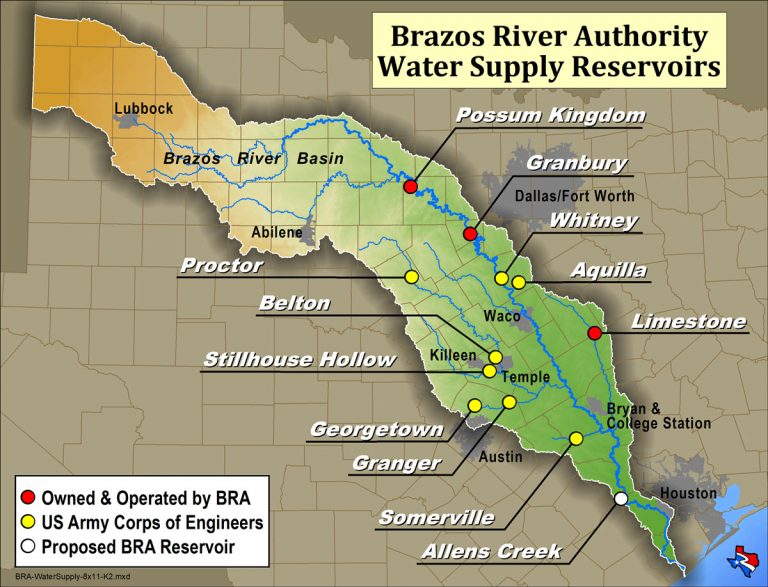By Brazos River Authority
PALO PINTO COUNTY – Spring has sprung. Flowers are blooming. Crops are growing. And Texas is being Texas.
Some areas of the Brazos River Basin have seen rain this year, enough to keep reservoirs filled; while other areas of the basin haven’t been so lucky.
After a few winter months of La Niña conditions, the tropical Pacific is now moving to ENSO-neutral, and the National Weather Service Climate Prediction Center (NOAA) forecasters expect neutral conditions to continue throughout the Northern Hemisphere into the summer months.
What does that mean for the Brazos River Basin and reservoir levels?
NOAA predicts that April, May and June are favorable for above-normal temperatures and below-normal rainfall.
“La Niña brings above normal temps and drier weather for us,” says Aaron Abel, water services manager at the Brazos River Authority. “El Niño typically brings above normal rainfall and potentially cooler temperatures. In February, we did have a La Niña advisory in place, and we typically see less rainfall in the winter.”
Although a La Niña advisory remained active, oceanic conditions consistent with La Niña weakened during February 2025, and ENSO neutral is favored to develop within the next 1-2 months.
“We seem to be moving out of La Niña. Probably the February-April average conditions will be neutral. But an El Niño (which would bring above-normal rain next winter) doesn’t seem to be in the cards,” advises John Nielsen-Gammon, Texas State Climatologist and director of the Southern Regional Climate Center at Texas A&M University. “More likely is continued neutral conditions or a repeat La Niña.”
“As of today, about 97% of the Brazos River Basin is at least abnormally dry. It’s not drought unless it’s D1 or worse, which presently is close to 80% of the basin,” explained Nielsen-Gammon. “Most of that 80% is D1. D3 is a possibility, with the seasonal outlook unfavorable for rainfall during the spring.”
The U.S. Drought Monitor identifies drought intensity on a scale of D0 to D4.
- D1 is abnormally drought
- D1 is moderate drought
- D2 is severe drought
- D3 is extreme drought
- D4 is exceptional drought
Nielsen-Gammon says, “In 2022 and 2023, we already had a good bit of extreme drought by this time of year.”
At this same time in 2024, the Brazos River Basin was experiencing 18% drought, with 9% categorized as D0 and 9 percent as D1.
Abel assures us that lake levels are in good shape for most of the reservoirs in the BRA’s system of reservoirs. “The BRA water supply reservoirs have been about 93 to 94 percent full since mid-November.”
“We did just move to a Stage 1 drought watch at Stillhouse Hollow Lake, Lake Georgetown and Lake Somerville,” Abel said. “We use the Palmer Hydrologic Drought Index (PHDI), a metric in our drought contingency plan for an early drought warning trigger.”
A Stage 1 drought watch encourages customers to implement a 5% reduction of water use that would have occurred in the absence of any drought contingency measures.
Reservoir levels at those three lakes are currently not at capacity. Although we’re still two months away from the official start of hurricane season (June 1, 2025-November 30, 2025), predictions are already being made about how active the season might be.
Experts at Colorado State University’s Tropical Cyclones, Radar, Atmospheric Modeling and Software team (TC-RAMS) estimate that nine hurricanes will occur for the upcoming season, with 17 named storms overall.
The 2024 Atlantic hurricane season was active and destructive, with 18 named storms, 11 hurricanes and five major hurricanes. According to the Weather Channel, that total is rare in over 170 years.
Since 1851, only 8 other Atlantic hurricane seasons have generated 11 or more hurricanes. Three of these years have occurred in the past 20 years, most recently in 2020, and also in 2010 and 2005. The historic 2005 season holds the record for most hurricanes of any season when 15 hurricanes formed.
Colorado State University tropical scientist Phil Klotzbach noted 7 of the 2024 hurricanes formed from Sept. 25 through Nov. 5, the most on record in that specific time frame since 1851.
With neutral conditions, it remains to be seen which way our spring weather will go. It could be wet or dry. April – June are normally the wettest months of the year for the Brazos River Basin.
However, if we experience a spring with less rain, we’ll need to be more careful with how we use water and stay cool. Small things like turning off sprinklers when it rains or taking shorter showers can help.
Until we see what Mother Nature sends us leading into the summer months, being aware of the weather and staying prepared is a smart way to protect yourself and your family.




